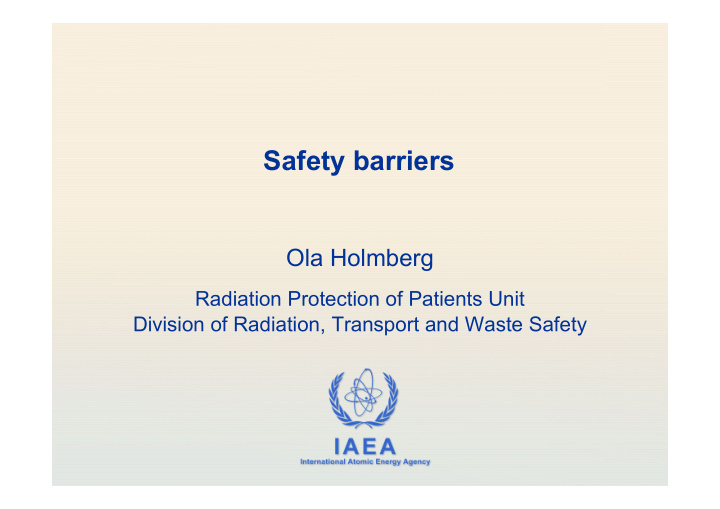



Safety barriers Ola Holmberg Radiation Protection of Patients Unit Division of Radiation, Transport and Waste Safety IAEA International Atomic Energy Agency
Radiation incidents and accidents IAEA
Radiation incidents and accidents IAEA
Radiation incidents and accidents Similar events in France 2004 and U.S.A some years later IAEA From: W. Bogdanich, N.Y.Times, USA
Radiation incidents and accidents Similar events in France 2007 and U.S.A some years later From: S. Derreumaux, IRSN, France IAEA
Radiation incidents and accidents IAEA
Radiation incidents and accidents • Still difficulties in ensuring systematic learning from radiotherapy safety- related events that have happened IAEA
Radiation incidents and accidents • Radiation accidents involving medical uses: • Over the last three decades, at least 3000 patients have been affected by radiotherapy incidents and accidents • Radiation accidents involving medical uses have accounted for more acute radiation deaths than any other source, including Chernobyl • These accidents do not only affect patients directly (e.g. harm and death), but might also undermine the public’s confidence in the treatment • Preventable medical errors overall also cost countries billions of dollars each year IAEA UNSCEAR 2008 Report, Volume II, Annex C
Radiation incidents and accidents • Radiotherapy-related error rate compares favourably with the rate of other medical errors* (*World Health Organization: Radiotherapy Risk Profile 2008) IAEA
In a radiotherapy facility Initiating events Patients IAEA
In a radiotherapy facility Initiating events Patients IAEA
In a radiotherapy facility Initiating events Patients More severe consequences IAEA
In a radiotherapy facility Initiating events Safety barriers Patients Swiss cheese model IAEA
In a radiotherapy facility Initiating events Safety barriers Patients Safety barriers (procedures or equipment), e.g.: Patient identification card; Independent check of monitor units; Verification of data transferred to the LINAC; Personalized positioning and immobilization devices; Initial portal imaging; IAEA Initial in-vivo dose verification
In a radiotherapy facility Initiating events Safety barriers Patients Consequence reducers IAEA
In a radiotherapy facility Initiating events Safety barriers Patients Consequence reducers Consequence reducers (procedures or equipment), e.g.: Weekly quality control; Weekly chart check; Weekly medical IAEA review
In a radiotherapy facility Initiating events Safety barriers Patients Frequency reducers Consequence reducers IAEA
In a radiotherapy facility Initiating events Safety barriers Patients Frequency reducers Consequence reducers Frequency reducers, e.g.: Workload according to staffing level; Staff training in radiation safety; Preventive maintenance IAEA
In a radiotherapy facility PROSPECTIVE RISK ANALYSIS: SEVRRA (risk evaluation software tool) developed under the Ibero- American Regulators Forum (FORO) IAEA
Bonn Call-for-Action • Action 7: Improve prevention of medical radiation incidents and accidents • a) Implement and support voluntary educational safety reporting systems for the purpose of learning from the return of experience of safety related events in medical uses of radiation; • c) Work towards inclusion of all modalities of medical usage of ionizing radiation in voluntary safety reporting, with an emphasis on brachytherapy, interventional radiology, and therapeutic nuclear medicine in addition to external beam radiotherapy; • d) Implement prospective risk analysis methods to enhance safety in clinical practice; IAEA
Finally Taking the Swiss Cheese Model … … towards Gruyère … from Emmentaler … IAEA
Recommend
More recommend